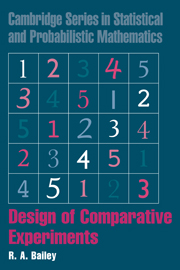Book contents
- Frontmatter
- Contents
- Preface
- 1 Forward look
- 2 Unstructured experiments
- 3 Simple treatment structure
- 4 Blocking
- 5 Factorial treatment structure
- 6 Row–column designs
- 7 Experiments on people and animals
- 8 Small units inside large units
- 9 More about Latin squares
- 10 The calculus of factors
- 11 Incomplete-block designs
- 12 Factorial designs in incomplete blocks
- 13 Fractional factorial designs
- 14 Backward look
- Exercises
- Sources of examples, questions and exercises
- Further reading
- References
- Index
10 - The calculus of factors
Published online by Cambridge University Press: 30 October 2009
- Frontmatter
- Contents
- Preface
- 1 Forward look
- 2 Unstructured experiments
- 3 Simple treatment structure
- 4 Blocking
- 5 Factorial treatment structure
- 6 Row–column designs
- 7 Experiments on people and animals
- 8 Small units inside large units
- 9 More about Latin squares
- 10 The calculus of factors
- 11 Incomplete-block designs
- 12 Factorial designs in incomplete blocks
- 13 Fractional factorial designs
- 14 Backward look
- Exercises
- Sources of examples, questions and exercises
- Further reading
- References
- Index
Summary
Introduction
In the preceding chapters we have met all the principles of orthogonal designs (which will be defined in Section 10.12). The plots may be unstructured, as in Chapter 2. There may be a single system of blocks, as in Chapter 4. If there are two systems of blocks then we may have each block of one system meeting each block of the other system, as in Chapter 6 and Section 7.3, or each block of one system may contain several blocks of the other system, as in Section 8.3. The experimental units may be the same as the observational units, or each experimental unit may contain several observational units, as in Section 8.1.
The treatments also may be unstructured, as in Chapter 2. They may be divided into different types, such as control and new treatments, as in Chapter 3. They may consist of all combinations of two or more treatment factors, as in Chapter 5. The different treatment effects may all be estimated in the same stratum, or they may be estimated in two or more strata, as in Sections 8.2–8.4. We may even assume that some interactions are zero, as in Chapter 9.
The purpose of the present chapter is to give a unifying framework that not only encompasses all the designs we have met so far but also permits the construction and analysis of infinitely many more. Once this framework is understood there is absolutely no need to memorize the structure of any individual named design.
The reader may wish to omit proofs on a first reading of this chapter.
- Type
- Chapter
- Information
- Design of Comparative Experiments , pp. 169 - 218Publisher: Cambridge University PressPrint publication year: 2008



